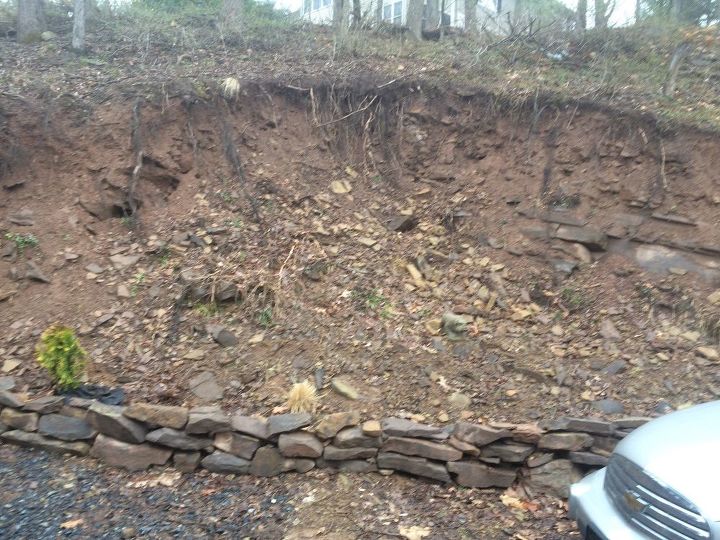Landscaping and planting ideas for cliff next to house and driveway

Related Discussions
GNATS - How to get rid of them?
Somehow my house and garden got tiny gnats that killed my fuchsia plant and fly everywhere. I have tried ALL the Web recommendations - soap and oil dishes, sand in th... See more
Marigolds growing! Should I pinch the buds?
My marigold plants are growing. I heard that pinching the buds until Autumn will allow them to grow without killing the plant. Is this true?
Growing garlic
Growing our first garlic, should we wait until the leaves are drying out before we pick it? Husband picked first one today along with our first potatoes.
How to keep mice out of your garden?
Hi everyone, I have mice in my garden destroying my vegetables and I have also noticed them in the barn and shed. Please can someone tell me how to prevent them from ... See more
What's the best flower/plant to grow in Texas?
I know that opinions vary, but what's your opinion?!I have great luck w Rosemary plants. Green all year long.
Best way to kill bush/tree after being cut down?
Just moved into a new home. There was a huge thorny bush dragon devouring the mailbox. I slayed the dragon but it is trying to rise up again. How can I make sure it's... See more
Nightmare neighbors
We have the worst neighbors ever! They complain about everything! They hate dogs so they complain every time our dogs bark one time (not exaggerating) they have fabri... See more







Location is necessary to answer your question
The Seattle Times has an article online “there’s hope for slopes.” They strongly suggest native plants. Call or, check online, your County or state agricultural extension service. If there’s a college nearby, check them as well. If there’s a local gardening club, they might offer advice and even free cuttings. Or volunteers!
They all understand your weather conditions, etc, and no doubt have a great list of native plants that will hold the land and thrive.
Rock Garden with paths running though
Not sure where you are, but i would try hosta. The spread fast and their dense roots would help hold the soil.
I live on a Island and experience erosion of land from TIDE and rain waters.
And ,I've found that putting a modified rain gutter at _the top of the land witch redistributes the water ( kinda like a sprinkler) helps and then plant whatever is best in you area to maximize the draiinage.
Eastern Pa
I would do some type of low growing ground cover. There are a lot that bloom also, just look for those hearty to your area. A quick google search of "low growing blooming ground cover gave me several site to look at for options. Your soil type will also play a major part in the type of plant chosen. Best wishes and happy gardening.
Thrift would be a beautiful creeping plant there; dianthus might be an option too. A very easy ground cover is sedum; you can just stick a stem of it in the ground, and it will take root. It's a fast grower too.
Creeping Vinca or good old Ivy.
This slope is unstable and planting on it will not solve the problem. The slope needs to be regraded so that is no steeper than 1 foot high for each 2 feet of run. Then you have a plantable slope, using most any plant that grows well in those soils, light and climate.
The slope angle may be changed by either cutting it back on the top end, or installing a retaining wall at the lower end and then backfilling. You could also loosely stack rocks with soil pockets interspersed and place plants in the gaps as you go. This is not a simple do it your self project.
You might try crown vetch. tough, very hardy, holds soil, no maintenance and has pretty flowers
Depending how often you go by there. I have always like wild strawberries. They have great roots which hold the soil and you get fruit in the spring. just a win-win in my book.
If you want to block weeds you can put landscape fabric
Hi Debbie, hope this helps you out. You can actually plant native grasses and shrubs into the side of the cliff, it will helps stabilize the side as well. Just dig in and plant the shrubs sideways, they will straighten on their own. Low maintenance like Boxwood, Dwarf Gardenia, Rosemary, and Rhododendron. You can add in a variety of sizes to add some extra curb appeal as well as flowering, evergreen, and deciduous shrubs. Or daylilies, creeping phlox, lamb's ears, stonecrop and a variety of ornamental grasses. A number of woody plants can also serve as good groundcovers, especially creeping juniper, fragrant sumac, bearberry, and Russian arborvitae. Naturally deep-rooted grasses that establish quickly, such as turf-type tall fescue grasses, are excellent choices for erosion-prone spots. Fast-germinating annual and perennial ryegrasses help stabilize slopes quickly and control erosion while deeper rooted grasses become established and take hold.
Look for plants with very good root sturcture to add stability to the area. Go with plants that are lower to the ground and have excellent roots without being invasive.